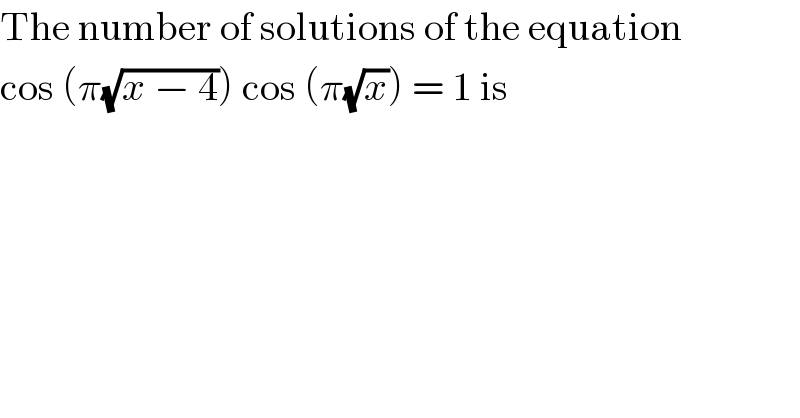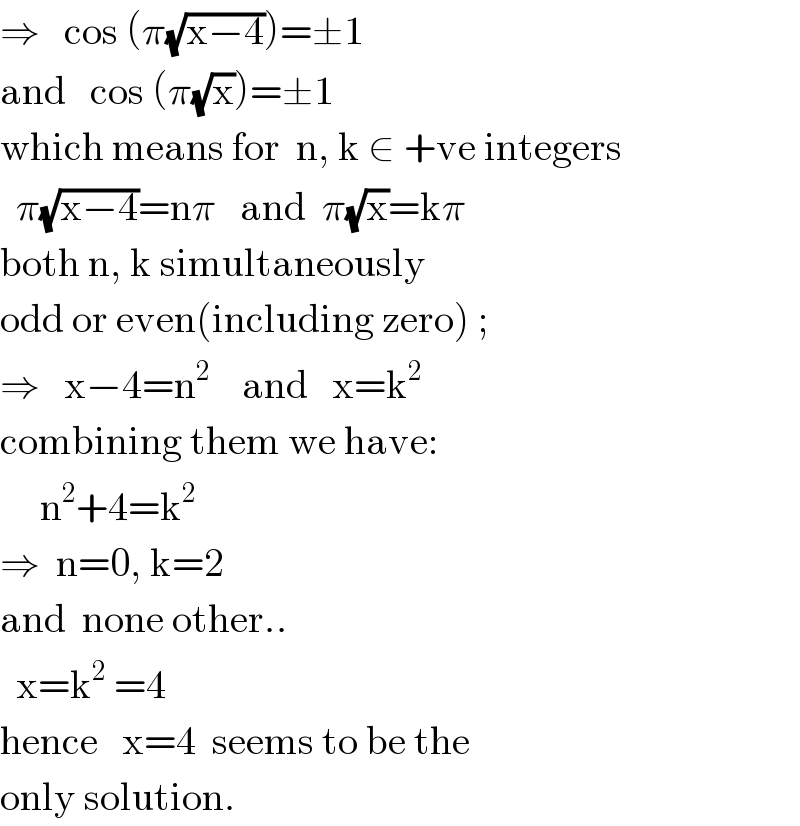
Question Number 17148 by Tinkutara last updated on 01/Jul/17

$$\mathrm{The}\:\mathrm{number}\:\mathrm{of}\:\mathrm{solutions}\:\mathrm{of}\:\mathrm{the}\:\mathrm{equation} \\ $$$$\mathrm{cos}\:\left(\pi\sqrt{{x}\:−\:\mathrm{4}}\right)\:\mathrm{cos}\:\left(\pi\sqrt{{x}}\right)\:=\:\mathrm{1}\:\mathrm{is} \\ $$
Answered by ajfour last updated on 01/Jul/17

$$\Rightarrow\:\:\:\mathrm{cos}\:\left(\pi\sqrt{\mathrm{x}−\mathrm{4}}\right)=\pm\mathrm{1} \\ $$$$\mathrm{and}\:\:\:\mathrm{cos}\:\left(\pi\sqrt{\mathrm{x}}\right)=\pm\mathrm{1} \\ $$$$\mathrm{which}\:\mathrm{means}\:\mathrm{for}\:\:\mathrm{n},\:\mathrm{k}\:\in\:+\mathrm{ve}\:\mathrm{integers} \\ $$$$\:\:\pi\sqrt{\mathrm{x}−\mathrm{4}}=\mathrm{n}\pi\:\:\:\mathrm{and}\:\:\pi\sqrt{\mathrm{x}}=\mathrm{k}\pi \\ $$$$\mathrm{both}\:\mathrm{n},\:\mathrm{k}\:\mathrm{simultaneously} \\ $$$$\mathrm{odd}\:\mathrm{or}\:\mathrm{even}\left(\mathrm{including}\:\mathrm{zero}\right)\:; \\ $$$$\Rightarrow\:\:\:\mathrm{x}−\mathrm{4}=\mathrm{n}^{\mathrm{2}} \:\:\:\:\mathrm{and}\:\:\:\mathrm{x}=\mathrm{k}^{\mathrm{2}} \\ $$$$\mathrm{combining}\:\mathrm{them}\:\mathrm{we}\:\mathrm{have}: \\ $$$$\:\:\:\:\:\mathrm{n}^{\mathrm{2}} +\mathrm{4}=\mathrm{k}^{\mathrm{2}} \\ $$$$\Rightarrow\:\:\mathrm{n}=\mathrm{0},\:\mathrm{k}=\mathrm{2} \\ $$$$\mathrm{and}\:\:\mathrm{none}\:\mathrm{other}.. \\ $$$$\:\:\mathrm{x}=\mathrm{k}^{\mathrm{2}} \:=\mathrm{4}\: \\ $$$$\mathrm{hence}\:\:\:\mathrm{x}=\mathrm{4}\:\:\mathrm{seems}\:\mathrm{to}\:\mathrm{be}\:\mathrm{the}\: \\ $$$$\mathrm{only}\:\mathrm{solution}. \\ $$
Commented by Tinkutara last updated on 01/Jul/17

$$\mathrm{Thanks}\:\mathrm{Sir}! \\ $$
